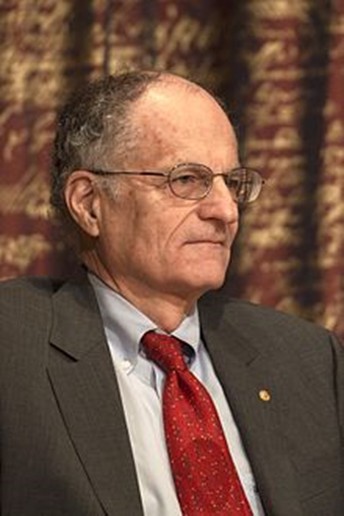
Thomas J. Sargent
USINFO | 2013-11-20 15:39
Nobel Memorial Prize in Economic Sciences (2011) Laureate
 |
|
| Born |
July 19, 1943 (age 70) Pasadena, California |
| Nationality | American |
| Institution | New York University |
| Field | Macroeconomics, monetary economics |
| Alma mater |
UC Berkeley, (B.A.) Harvard University, (PhD) |
| Influences |
Robert Lucas, Jr. John Muth |
| Awards |
NAS Award for Scientific Reviewing (2011) Nobel Memorial Prize in Economic Sciences (2011) |
Thomas John "Tom" Sargent (born July 19, 1943) is an American economist, specializing in the fields of macroeconomics, monetary economics and time series econometrics. He is currently a Professor of Economics at New York University. As of 2011, he ranks seventeenth among the most cited economists in the world. He was awarded the Nobel Prize in Economics in 2011 together with Christopher A. Sims "for their empirical research on cause and effect in the macroeconomy".
Education
Sargent earned his B.A. from the University of California, Berkeley in 1964, being the University Medalist as Most Distinguished Scholar in Class of 1964, and his Ph.D. from Harvard in 1968. He held teaching positions at the University of Pennsylvania (1970–1971), University of Minnesota (1971–1987), University of Chicago (1991–1998), Stanford University (1998–2002) and Princeton University (2009), and is currently a Professor of Economics at New York University (since 2002). He is a Fellow of the Econometric Society since 1976. In 1983, Sargent was elected to the National Academy of Sciences and also the American Academy of Arts and Sciences. He has been a senior fellow of the Hoover Institution at Stanford University since 1987, and a member of the Advisory Board of the Penn Institute for Economic Research at the University of Pennsylvania.
Professional contributions
Sargent is one of the leaders of the "rational expectations revolution", which argues that the people being modeled by economists can predict the future, or the probability of future outcomes, at least as well as the economist can with his model. Rational expectations was introduced into economics by John F. Muth, then Robert Lucas, Jr., and Edward C. Prescott took it much farther.
Sargent's main contributions to rational expectations were to:
trace the implications of rational expectations, with Neil Wallace, for alternative monetary-policy instruments and rules on output stability and price determinacy.
help make the theory of rational expectations statistically operational.
provide some early examples of rational expectations models of the Phillips curve, the term structure of interest rates, and the demand for money during hyperinflations.
analyze, along with Neil Wallace, the dimensions along which monetary and fiscal policy must be coordinated intertemporally.
conduct several historical studies that put rational expectations reasoning to work to explain consequences of dramatic changes in macroeconomic policy regimes.
In 1975 he and Neil Wallace proposed the Policy-ineffectiveness proposition, which refuted a basic assumption of Keynesian economics.
Sargent went on to refine or extend rational expectations reasoning by:
studying the conditions under which systems with bounded rationality of agents and adaptive learners converge to rational expectations.
using the notion of a self-confirming equilibrium, a weaker notion of rational expectations suggested by limits of learning models.
studying contexts with Lars Peter Hansen in which decision makers do not trust their probability model. In particular, Hansen and Sargent adapt and extend methods from robust control theory.
Sargent has also been a pioneer in introducing recursive economics to academic study, especially for macroeconomic issues such as unemployment, fiscal and monetary policy, and growth. His series of textbooks co-authored with Lars Ljungqvist are seminal in the contemporary graduate economics curriculum.
Sargent has pursued a research program with Lars Ljungqvist designed to understand determinants of differences in unemployment outcomes in Europe and the United States during the last 30 years. The key questions this program addresses are: 1) Why during the 1950s and 1960s was unemployment systematically lower in Europe than in the United States? 2) Why for two and a half decades after 1980 has unemployment been systematically higher in Europe than in the United States? In "Two Questions about European Unemployment", the answer is given that "Europe has stronger employment protection despite also having had more generous government supplied unemployment compensation". While this institutional differences remained the same over this time period, the microeconomic environment for workers changed, with a higher risk of human capital depreciation in the 1980s.
In 2011 Sargent was awarded the NAS Award for Scientific Reviewing from the National Academy of Sciences and, in September, he became the recipient of the 2011 CME Group-MSRI Prize in Innovative Quantitative Applications.
Sargent is known as a devoted teacher. Among his PhD advisees are men and women at the forefront of macroeconomic research. Sargent's reading group at Stanford and NYU is a famous institution among graduate students in economics.
Nobel Memorial Prize and lecture
On October 10, 2011, Sargent together with Chris Sims was awarded the Nobel Memorial Prize in Economic Sciences. The award cited their "empirical research on cause and effect in the macroeconomy". His Nobel lecture, titled "United States Then, Europe Now" was delivered on December 11, 2011.
Popular Culture
He is featured playing himself in a television commercial for Ally Bank in which he is asked if he can predict CD rates two years from now to which he simply answers: "No."
Share this page



















